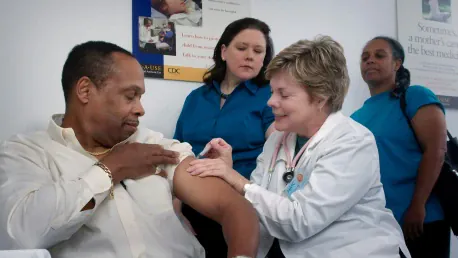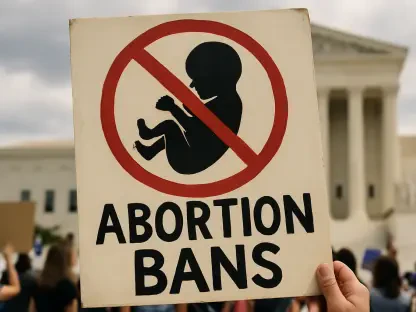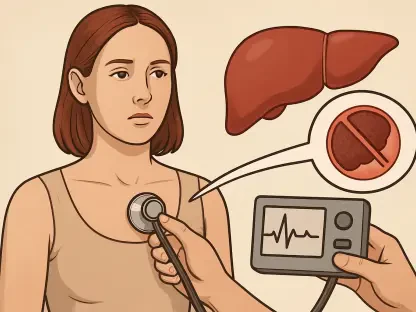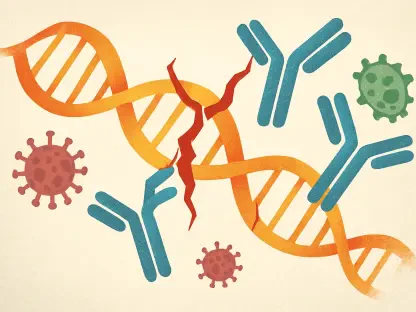The U.S. Department of Health and Human Services (HHS) is experiencing a turbulent phase marked by extensive layoffs and a major reorganization under Secretary Robert F. Kennedy Jr. These moves have ignited substantial controversy and legal battles, drawing sharp reactions from various stakeholders involved.
Extent and Error in Layoffs
The sweeping layoffs at HHS involved terminating 10,000 employees, a significant reduction in the workforce aimed at restructuring the department. However, the process was marred by substantial errors, with 2,000 of these terminations being identified as wrongful. The plans to reinstate these individuals underscore the issues in how the layoffs were managed, revealing flaws in oversight and execution. This scenario has raised questions about the underlying methods and processes used by HHS in these drastic measures, leading to concerns about potential mismanagement and lack of precision in workforce reductions.
Division Impacts
The layoffs have deeply affected numerous divisions within HHS, disrupting essential services and operations. The Centers for Medicare and Medicaid Services (CMS) have been significantly impacted, with the reduction in staff potentially hindering their ability to monitor medical fraud and provide vital services to beneficiaries. Similarly, the Food and Drug Administration (FDA) faces challenges with reduced personnel, which might impair their capacity to ensure food and drug safety and maintain public trust in regulatory processes.
The Centers for Disease Control and Prevention (CDC) have seen cuts in crucial programs like infectious disease surveillance and tobacco control. These reductions could weaken efforts in disease prevention and control, thus posing risks to public health safety. The National Institutes of Health (NIH) also encounter workforce reductions that could negatively affect ongoing research and development initiatives, jeopardizing advancements in medical science and innovation that are fundamental to disease cure and prevention strategies.
Political and Advocacy Responses
In response to the extensive layoffs, health advocacy groups, policymakers, and labor unions have expressed significant opposition. Health organizations have highlighted the risks posed to public health due to reduced preventive programs and the potential gaps in services that could emerge from the workforce cuts. Public health infrastructure could be compromised, leading to greater vulnerabilities in disease control and prevention.
Policymakers have also debated the implications of these layoffs, focusing on how reduced workforce numbers could negatively impact community services, particularly those that depend heavily on the support of HHS. The debate continues over the balance between improving efficiency and maintaining adequate public health services. Labor unions have initiated legal actions challenging the mass layoffs, defending the rights and protections of federal employees. These legal battles highlight the ethical and legal dimensions of such extensive workforce reductions.
Reorganization Goals
The reorganization under Secretary Kennedy aims to streamline operations and enhance efficiency within HHS. One primary goal is consolidating overlapping offices to reduce redundancy, intending to create a more focused and effective administrative structure. However, while consolidation could potentially cut down bureaucratic overhead, it raises significant questions about whether such restructuring can be effectively implemented without disrupting service continuity or compromising the quality of health services.
Centralizing various administrative functions is another strategy, proposed to shape a leaner organizational setup for HHS. This centralization seeks to optimize resources and ensure better coordination across different divisions. However, practical concerns remain about achieving these efficiency goals without losing critical expertise and operational capacities essential for managing public health concerns and emergencies.
Long-term Concerns and Ramifications
Experts and stakeholders have raised alarms about the long-term implications of the ongoing restructuring. One major concern is the heightened risk to public health stemming from weakened disease prevention programs and compromised safety regulations. Essential services, such as Meals on Wheels and rural healthcare support, may face significant disruptions. Vulnerable populations, including seniors and underserved communities, could experience adverse effects due to reduced aid and assistance.
Furthermore, the impact on HHS’s ability to respond effectively to health crises is a point of concern. Decreased workforce and consolidated functions might slow down response times and affect the department’s agility in addressing emerging public health threats. The long-term ramifications of such an extensive reorganization could endanger the robustness of the nation’s health infrastructure, leading to potential increases in disease outbreaks and higher healthcare costs.
Legal and Union Pushback
In light of the extensive layoffs, legal challenges and union resistance have surfaced, targeting the legality and ethicality of the terminations. Lawsuits have been filed, contending that the manner in which the workforce reductions were carried out breaches federal workers’ rights and ethical standards set for operating within public health services. These legal actions strive to safeguard employee rights and ensure that such significant changes are implemented with due respect to legal protocols and ethical considerations.
Union critiques have been vocal, emphasizing the critical need to maintain workforce stability to ensure the consistent delivery of robust public health services. The unions argue that maintaining a dedicated workforce is vital for the effective functioning of HHS and safeguarding public health interests. The resistance encompasses calls for reconsideration of the layoff strategies to prevent long-term damage to the health service framework.
Operational and Service Disruptions
The extensive job cuts have precipitated potential operational challenges within HHS, affecting specific programs severely. The CDC’s initiatives on infant health and personal protective equipment certification are under threat due to reduced staffing. Such cuts could jeopardize critical health initiatives and weaken preparedness for future health crises.
Similarly, the NIH’s research endeavors, including those focused on disease prevention, might face setbacks. Reduced staffing and resources could hinder progress in medical research, ultimately impacting the development of new treatments and preventive measures for various diseases. The operational disruptions stemming from workforce reductions expose vulnerabilities in the department’s capacity to deliver essential services and maintain its pivotal role in public health.
Addressing Mismanagement and Errors
The reinstatement of mistakenly terminated employees underscores the broader issues in the layoff process. Mismanagement and inefficiencies in executing such significant workforce reductions have been highlighted, raising concerns about the department’s internal oversight mechanisms. This scenario emphasizes the need for careful planning and meticulous execution in restructuring efforts to avoid similar errors in future operations.
Addressing these management flaws is crucial for HHS to recover and implement its reorganization goals effectively. Ensuring that workforce termination processes are conducted with precision and accountability is necessary to maintain public trust and operational integrity. These reinstatement plans signify efforts to correct errors and manage the fallout from misguided layoff decisions.
Public Health Impact
Widespread criticism has emerged, highlighting the potential adverse effects of layoffs and restructuring on public health. Experts warn that cuts to programs for HIV prevention, infectious disease control, and public safety measures could escalate public health risks. Reductions in efforts to prevent and control diseases might lead to increased outbreaks, burdening the healthcare system and potentially causing higher healthcare costs.
These changes threaten the efficacy of HHS in managing public health issues comprehensively. The cumulative effect of reduced workforce capacity and compromised preventive programs could undermine national health security, making it challenging to address ongoing and emerging health threats effectively. The public health impact of such restructuring remains a critical concern among stakeholders and advocacy groups.
Legislative and Advocacy Reactions
Reactions from political leaders and health advocates continue to shape the debate surrounding the HHS layoffs and reorganization. Legislators have called for a reassessment of the reorganization strategy, advocating for modifications that protect public health interests. Legislative initiatives aim to balance the need for efficiency with the imperative to maintain strong public health systems.
Health advocacy groups are mobilizing to challenge the negative impacts of the layoffs, working to protect preventive programs and essential services crucial to community health. These advocacy efforts strive to support and sustain HHS’s core functions while navigating the complexities of implementing broad organizational changes.
Strategic Goals and Implementation
The vision to create a more efficient HHS through consolidation and centralization faces scrutiny regarding its practicality and potential outcomes. Consolidating functions and eliminating redundant offices aim for streamlined operations, yet the real-world implementation of these strategies prompts considerable uncertainty. Stakeholders question whether such goals can be achieved without sacrificing critical expertise and operational fluidity essential for public health service delivery.
The practical outcomes and sustainability of these strategic changes remain areas of active debate. Ensuring that reorganization leads to genuine improvements in efficiency without harming essential health services is central to its success. Robust planning and precise execution are required to navigate the inherent challenges and achieve the intended benefits of such extensive reorganization.
Challenges in Execution
Implementing significant changes within a large federal department like HHS poses substantial hurdles. Ensuring the continuous provision of services while maintaining workforce morale are critical concerns amidst restructuring. The challenges of adapting to new organizational structures and processes require a concerted effort and diligent transition management.
The practical execution of layoffs and reorganization demands rigorous planning and clear communication with stakeholders. Balancing efficiency aims with the need to protect public health and maintain service quality poses formidable challenges that require strategic foresight and robust management practices.
Comprehensive Overview
The narrative surrounding HHS’s job cuts and reorganization paints a comprehensive picture of a department grappling with substantial changes. Balancing ambitions for governmental efficiency with political strategy and public health imperatives is pivotal in managing the ongoing transformation. The controversy underscores the complex interplay of these factors within one of the U.S.’s key health agencies, reflecting broader implications for public health and service delivery.
Implications for Public Health and Services
Debates continue over the long-term ramifications for public health and essential services as HHS undergoes restructuring. Risk assessments indicate the need for robust disease prevention protocols and health safety measures to mitigate potential adverse outcomes. Stakeholders stress maintaining effective healthcare services for communities, especially those reliant on HHS’s support.
Ensuring that the reorganization leads to improved efficiency without compromising public health services remains a critical goal. The focus on safeguarding essential services and programs is fundamental to maintaining the integrity of HHS’s mission in promoting national health and well-being.
Ethical and Operational Dimensions
The mass layoffs and reorganization process within HHS are scrutinized for their ethical and operational implications. Labor rights and public health mandates highlight critical considerations in executing such extensive changes. Ethical concerns surrounding workforce stability and the impact on health services are central to the ongoing debate.
Balancing efficiency aims with ethical obligations to employees and public health mandates calls for thorough scrutiny and careful management. Ensuring that restructuring efforts adhere to ethical standards and protect vital health services is essential for sustaining trust and operational integrity in HHS’s mission.
Conclusion
The U.S. Department of Health and Human Services (HHS) is currently undergoing a significant period of upheaval. This phase is characterized by extensive layoffs and a major restructuring effort led by Secretary Robert F. Kennedy Jr. These actions have sparked considerable controversy and have led to a number of legal battles. Various stakeholders, including employees, advocacy groups, and other interested parties, have expressed strong reactions to the changes being implemented.
The restructuring aims to streamline operations and improve efficiency within the department, but it has been met with fierce opposition. Employees facing job losses are particularly vocal, and several lawsuits have already been filed in response to the layoffs. Advocacy groups argue that the rapid changes could undermine critical health services and impact vulnerable populations negatively.
Secretary Kennedy, however, maintains that these moves are necessary to ensure the department can adapt to evolving healthcare demands and operate more effectively. His vision includes reallocating resources to better address emerging health issues and improving overall service delivery.
As the controversy continues, the impact of these changes on the department and public health services remains to be seen. What is clear is that this period of transformation for HHS is far from over, with significant challenges and outcomes still unfolding.









